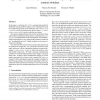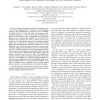667 search results - page 15 / 134 » Learning to Model Sequences Generated by Switching Distribut... |
110
click to vote
BMCBI
2005
14 years 11 months ago
2005
Background: General protein evolution models help determine the baseline expectations for the evolution of sequences, and they have been extensively useful in sequence analysis an...
108
click to vote
SPAA
1993
ACM
15 years 3 months ago
1993
ACM
In this paper we introduce the ConSet communication model for distributed memory parallel computers. The communication needs of an application program can be satisfied by some ar...
EMNLP
2007
15 years 1 months ago
2007
We describe a discriminatively trained sequence alignment model based on the averaged perceptron. In common with other approaches to sequence modeling using perceptrons, and in co...
118
Voted
ICDM
2009
IEEE
15 years 6 months ago
2009
IEEE
—Typical information extraction (IE) systems can be seen as tasks assigning labels to words in a natural language sequence. The performance is restricted by the availability of l...
JMLR
2010
14 years 6 months ago
2010
As we devise more complicated prior distributions, will inference algorithms keep up? We highlight a negative result in computable probability theory by Ackerman, Freer, and Roy (...




